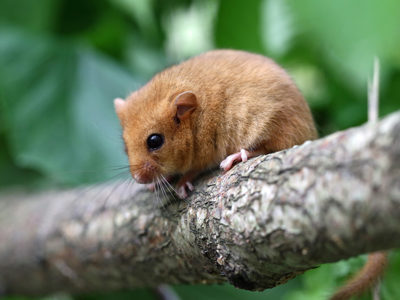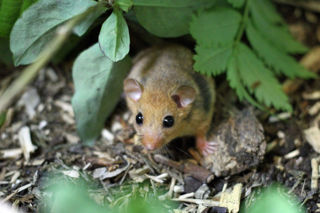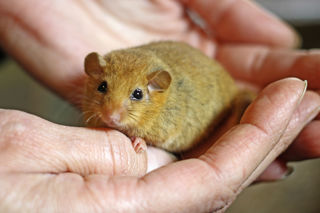
Hazel Dormouse
Muscardinus avellanarius
Key feature is its completely furred long tail. Fur colour is sandy yellow to orange. Very small ears in contrast to very large black eyes. Body length ranges from 6-9cm, with the tail being an additional 5-8cm long. Average weights range from 17-20g.

Behaviour
Strictly nocturnal and arboreal species. In summer, nests are created for dormice to sleep during the day; normally in a hollow tree or old bird nest. During the winter however, when food is scarce, dormice hibernate.
Woven nests of vegetation are constructed on the ground, where they will sleep until spring time (April or May). Just before hibernation, fat may comprise of up to half of their body mass, providing crucial energy to keep them alive during the winter months.

UK Status
The UK’s only native dormouse. Mainly found in the southern half of the UK, with strongholds in Devon, Somerset, Sussex and Kent. Numbers and distribution have declined dramatically within the last 100 years; population declined by 50% since 2000.
Hazel dormice are a Biodiversity Action Plan species (BAP); a status that offers protection and conservation plans in order to halt or reverse their decline. They are fully protected by law, and cannot be intentionally killed, injured, or disturbed in their nests. A license is also needed to trap, handle or collect them.

Threats
Habitat loss and changes in habitat management are a major cause of decline. Inappropriate woodland management alongside woodland and hedge fragmentation has become an increasing problem.
Climate change has also been highlighted, as warm spells during winter can wake dormice up prematurely, when no food is around. This fluctuating pattern of weather can have long term effects on populations, affecting springtime feeding and overall breeding success.
Distribution
Widespread throughout continental Europe. Also found in northern Asia.
Habitat
Woodland species (particularly deciduous) but can become associated with hedgerows and dense scrubland.
Diet
Varied diet of berries, nuts, nectar, flowers and some insects. Hazelnuts are a crucial part of their diet to allow them to fatten up for hibernation.
Wildwood
Our team of leading experts are helping to breed dormice for the national reintroduction programme. Not only that, Wildwood also manages the studbook for the species. For more information on our Hazel dormouse work, visit our conservation page.
Did you know?
One of only three British mammals that hibernates (bats and hedgehogs). During hibernation, the body temperature of a hibernating dormouse falls to that of its surroundings and its heart and breathing rate slow down by 90% or more.

